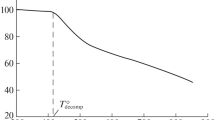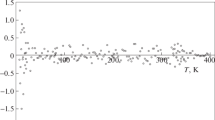Summary
Linear polyurethanes based on hexa(methylene diisocyanate) and oligo(ethylene glycoles) were studied using the methods of differential calorimetry, dilatometry and hot-stage microscopy. Thermodynamic analysis of melting and glass transition has shown that urethane groups lower the conformational entropy of melt, which results in a regular increase of bothT m andT g with concentration of these groups in the chain. Energy of intermolecular hydrogen bonding involving urethane groups was estimated by Zhurkov theory to be about 4 kcal/mole. Evidence is presented which suggests that glycole fragments in the crystalline state are “twisted” and depart from the extended conformation. This results not only in the increase of crystalline entropy and lowering of a crystalline packing density, but also in the decrease of a lattice cohesion energy, which then becomes dependent primarily by interactions between di(isocyanate) fragments of the chain crystallizing in the extended conformation. The described effect adequately accounts for the experimentally observed approximate constancy of thermodynamic fusion enthalpies of samples with different lengths of glycole components in the chain, as well as regular change of parametersσ e andG 0 in kinetic equations for the spherulitic growth rate.
Zusammenfassung
Lineare Polyurethane, basierend auf Hexamethylendiisocyanat und Oligoäthylenglykolen, wurden mit Differentialkalorimetrie, Dilatometrie und Hoch-temperaturmikroskopie untersucht. Die thermodynamische Analyse von Schmelz- und Glasübergang zeigt, daß Urethangruppen die Konformationsentropie der Schmelze erniedrigen,was sich zu einem regelrechten Anwachsen von beidem, Tm, undT g , mit der Konzentration von diesen Gruppen in der Kette auswirkt. Die Energie der zwischenmolekularen Wasserstoffbrückenbindung mit Urethangruppen wurde mit der Theorie vonZhurkov zu ungefähr 4 kcal/mol abgeschätzt. Es wird die Wahrscheinlichkeit dargelegt, daß Glykolfragmente in kristallinem Zustand verdrillt sind und von der gestreckten Konformation abweichen. Das resultiert nicht nur in einem Anwachsen der kristallinen Entropie und einem Absinken der kristallinen Packungsdichte, sondern auch in einer Abnahme der Gitterkohäsionsenergie, welche dann besonders abhängig vor allem von Wechselwirkungen zwischen Diisocyanat-Fragmenten in der kristallisierenden Kette in gestreckter Konformation wird. Der beschriebene Effekt ist gleicherweise verantwortlich für die experimentell beobachtete ungefähre Konstanz der thermodynamischen Schmelzenthalpien der Proben mit verschiedenen Längen der Glykolkomponente in der Kette, ebenso wie als reguläre Änderung der Parameterσ e undG 0 in den kinetischen Gleichungen für das Sphärolithwachstum.
Similar content being viewed by others
References
Saunders, J. H. andK. C. Frisch, Polyurethanes (New York, 1962).
Lipatov, Yu. S., Yu. Yu. Kercha, andL. M. Sergeeva, Structure and Properties of Polyurethanes (in Russian), Naukova Dumka (Kiev, 1970).
Godovskii, Yu. K. andYu. S. Lipatov, Vysokomol. Soe.A 10, 32 (1968).
Bunn, C. W., J. Polymer Sci.15, 355 (1955).
Privalko, V. P. andYu. S. Lipatov, Vysokomol. Soc.,A 14, 2000 (1972).
Vilenskii, V. A., A. E. Feinerman, andYu. Yu. Kercha, Information Bull. Institute of Macromolecular Chemistry, Academy of Sciences of the Ukrainian SSR, No. 19, Naukova Dumka (Kiev, 1973).
Pasechnik, Yu. V., V. A. Vilenskii, T. M. Gritsenko, andI. A. Popov, Sintez i Fiz.-Khim. Polimerov, No. 12, 112 (1973).
Wunderlich, B., J. Phys. Chem.64, 1052 (1960).
Wunderlich, B. andH. Baur, Adv. Polymer Sci.,7, 151 (1970).
Karasz, F. E., H. E. Bair, andJ. M. O'Reilly, J. Phys. Chem.69, 2657 (1965).
Gianotti, G. andA. Capizzi, Europ. Polymer J.4, 677 (1968).
Kercha, Yu. Yu., Yu. S. Lipatov, S. S. Krafchik, andV. P. Privalko, Vysokomol. Soed.A 15, 1297 (1973).
Gibbs, J. H. andE. A. DiMarzio, J. Chem. Phys.28, 373 (1958).
Dimarzio, E. A. andJ. H. Gibbs, J. Chem. Phys.28, 807 (1958).
Adam, G. andJ. H. Gibbs, J. Chem. Phys.43, 139 (1965).
Bestul, A. B. andS. S. Chang, J. Chem. Phys.40, 3731 (1964).
Kirsbenbaum, I., J. Polymer Sci.A 3, 1869 (1965).
Bondi, A., Physical Properties of Molecular Crystals, Liquids and Glasses (New York, 1969).
Van Krevelen, D. W., (in collaboration withP. J. Hoftyzer), Properties of Polymers (1972).
Mandelkern, L., Crystallization of Polymers (1963).
Privalko, V. P., Yu. S. Lipatov, A. P. Lobodina, andV. F. Shumskii, Vysokomol. Soed.A 16, 2771 No. 12 (1974).
Flory, P. J., Statistical Mechanics of Chain Molecules (New York 1969).
Hobbs, S. Y. andF. W. Billmeyer, Jr., J. Polymer Sci.A 2, 8, 1395 (1970).
Boyer, R. F., J. Macromol. Sci.-Phys.B 7, 487 (1973).
Privalko, V. P. andA. P. Lobodina, Europ. Polymer J.10, 1033 (1974).
Kanig, G., Kolloid-Z. Z. Polymere233, 54 (1969).
Privalko, V. P., (unpublished calculations).
Boyer, R. F., Rubber Chem. Technol.36, 1303 (1963).
Fox, T. G., Bull. Am. Phys. Soc.1, 123 (1956).
Zburkov, S. N., Dokl. Akad. Nauk USSR47, 493 (1945).
Privalko, V. P., Zh. Fiz. Khim.45, 1598 (1971).
Boyarchuk, Yu. M., L. Ya. Rappoport, V. N. Nikitin, andN. P. Apukhtina, Vysokomol. Soed.7, 778 (1965).
Zharkov, V. V. andN. K. Rudnevskii, Vysokomol. Soed.B 10, 29 (1968).
Miller, A. A., J. Chem. Phys.49, 1393 (1968).
Askadskii, A. A., G. L. Slonimskii, andA. I. Kitaigorodskii, Vysokomol. Soed.A 16, 474 (1974).
Slonimskii, G. L., A. A. Askadskii, andA. I. Kitaigorodskii, Vysokomol. Soed.A 12, 494 (1970).
Ishinabe, T., J. Phys. Soc. Japan30, 1022 (1971).
Privalko, V. P., Sintez i Fiz. Khim. Polimerov11, 51 (1972).
Privalko, V. P., Macromol.7, 111 (1973).
Privalko, V. P., Polymer J.,7, 202 (1975).
Hoffman, J. D., SPE Trans.4, 315 (1964).
Privalko, V. P., Vysokomol. Soed.A 15, 1905 (1973).
Privalko, V. P. andYu. S. Lipatov, Kolloid-Z. Z. Polymere251, 583 (1973).
Privalko, V. P. andYu. S. Lipatov, Vysokomol. Soed.B 15, 682 (1973).
Godovskii, Yu. K., Vysokomol. Soed.A 11, 2129 (1969).
Gandica, A. andJ. H. Magill, Polymer13, 595 (1972).
Shumskii, V. F. andV. P. Privalko, Sintez i Fiz.-Khim. Polimerov10, 58 (1972).
Privalko, V. P., Sintez i Fiz.-Khim. Polimerov14, 95 (1974).
Boon, J., G. Challa, andD. W. Van Krevelen, J. Polymer Sci.A 2, 6, 1791 (1968).
Author information
Authors and Affiliations
Rights and permissions
About this article
Cite this article
Lipatov, Y.S., Privalko, V.P., Kercha, Y.Y. et al. Thermodynamics and kinetics of phase transitions in linear polyurethanes from hexa(methylene diisocyanate) and low molecular weight glycoles. Colloid & Polymer Sci 254, 615–627 (1976). https://doi.org/10.1007/BF01753690
Received:
Issue Date:
DOI: https://doi.org/10.1007/BF01753690




